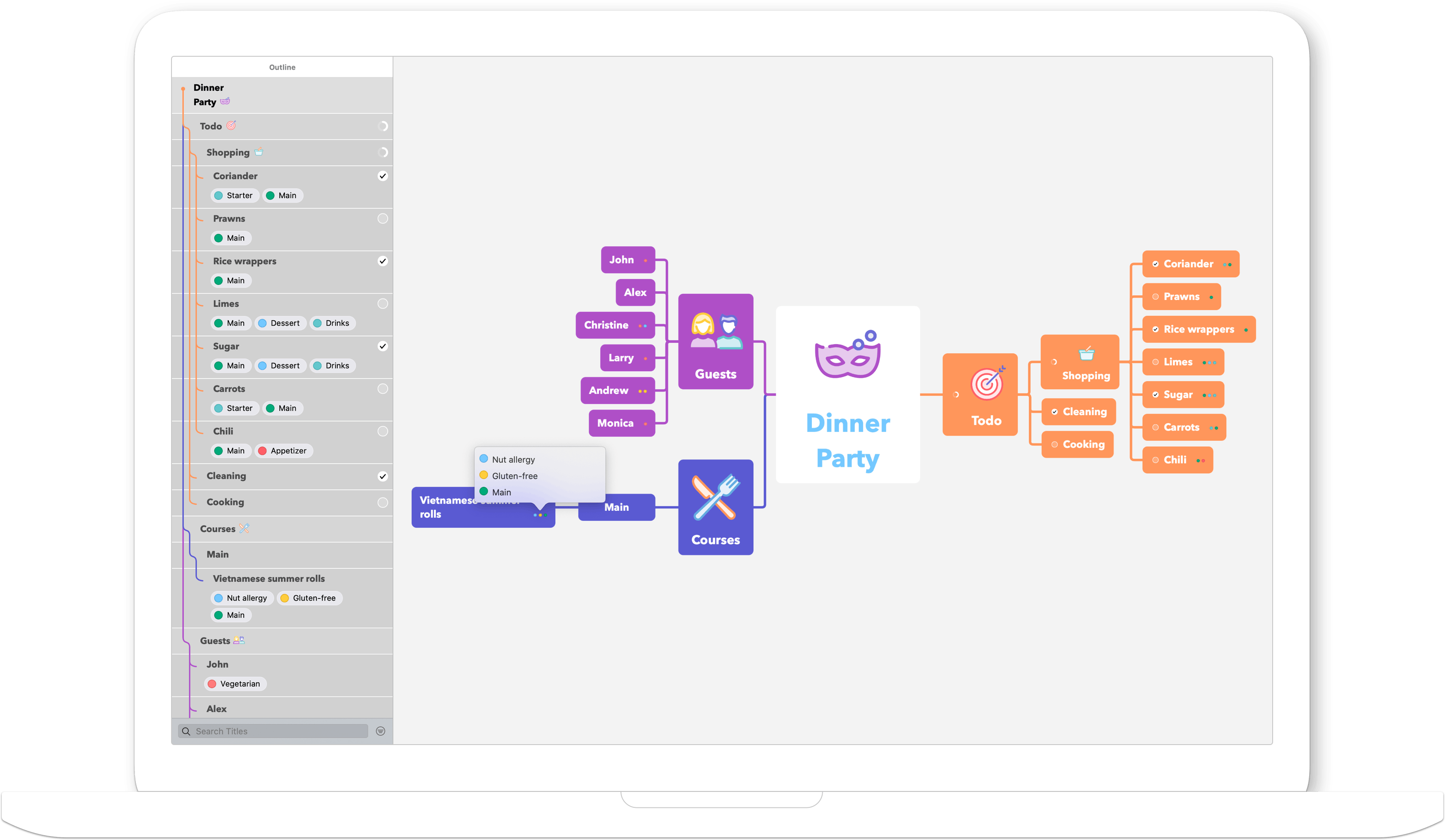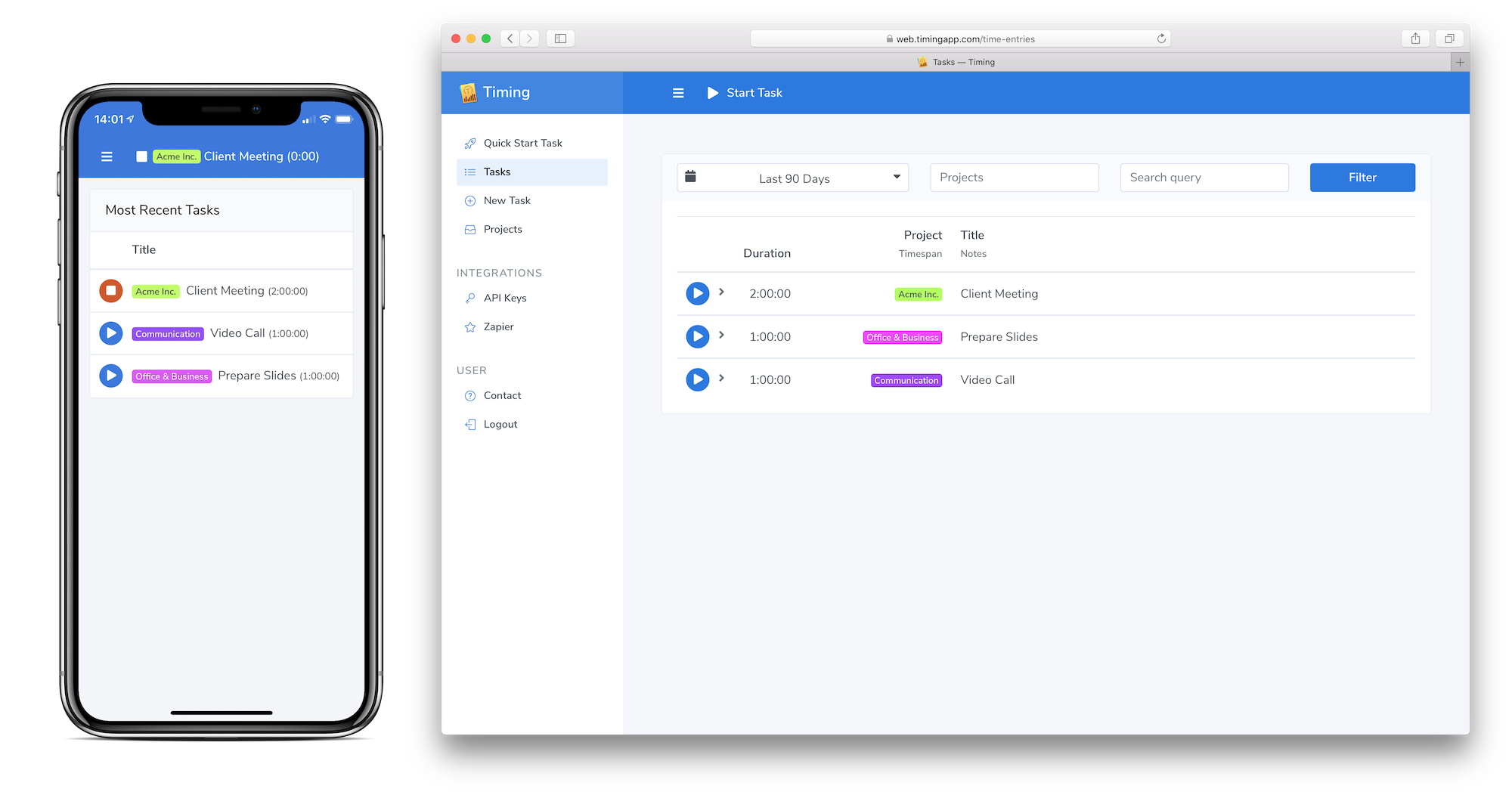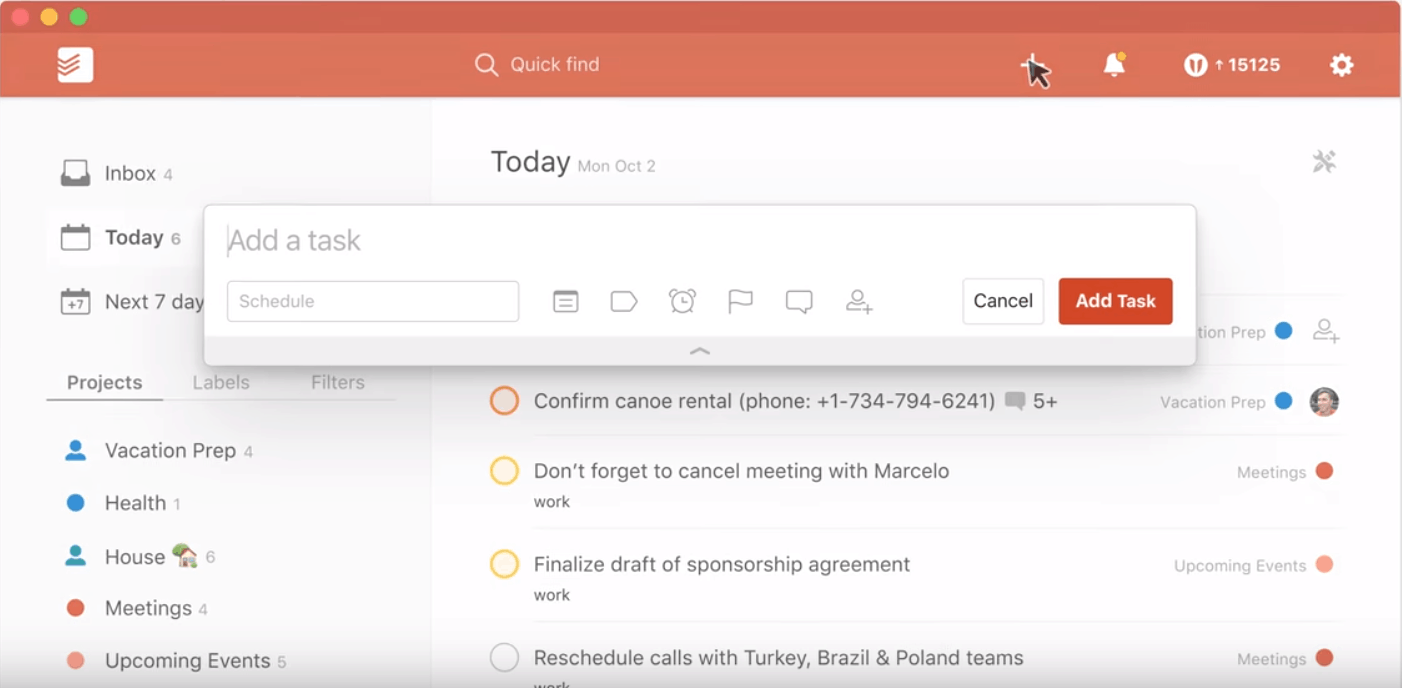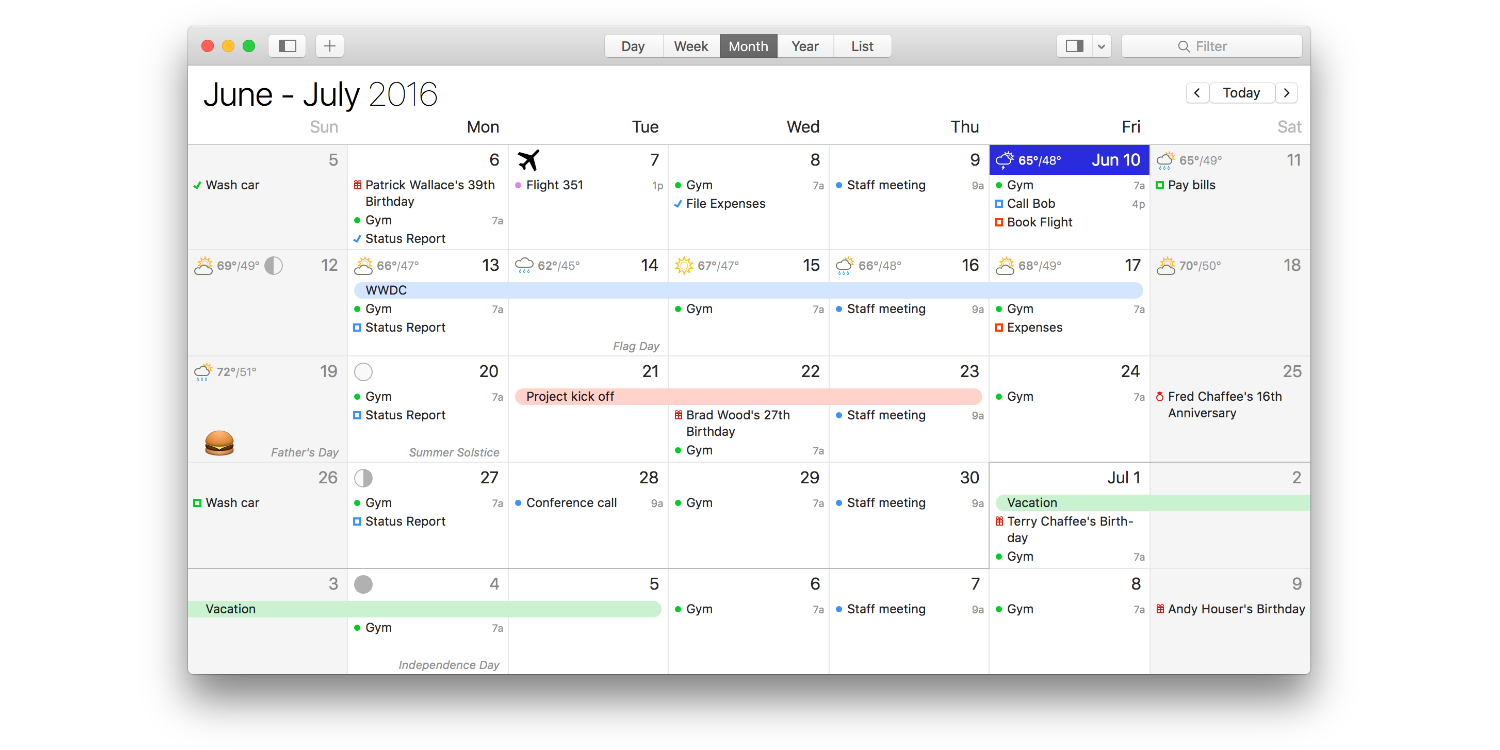- A Good Personal Daily Planning App For Macbook
- A Good Personal Daily Planning App For Mac Download
- A Good Personal Daily Planning App For Mac Os
- A Good Personal Daily Planning App For Macbook Pro
Keeping a calendar can change your life. A calendar will keep you from missing meetings and appointments, as well as make your life a lot less hectic. Plus, having all of your appointments on your calendar frees up your brain to work on more important tasks.
In our experience, digital calendars are far easier to manage than paper ones. Still, there are lots of calendar apps out there. Which one should you choose? In this article, we’ll help you decide.
Below, we’ve put together a list of the best calendar apps out there. Whether you’re looking for an app that gives you lots of control, or you just want a simple calendar that stays out of your way, there’s an app for you on this list.
Google Calendar
Download Planner Pro - Daily Calendar and enjoy it on your iPhone, iPad and iPod touch. Designed for those people who’re looking for a full-featured app to manage daily life better. Planner Pro, which costs years for designing and coding is now coming out for everybody.
Overview: A dependable calendar app that integrates with most productivity apps.
Google Calendar is an excellent cross-platform calendar app. It’s the default calendar on Android phones, and it also works well on iPhones. It’s simple to create new events whether you’re on your phone or computer, and everything always stays synced no matter what time zone you’re in.
- 1Password is an app for Mac that saves and remembers all your passwords for you in one place, so you can access all your favorite sites with a single click. You’ll save time and keep all your accounts secure simultaneously. A personal plan is $2.99 per month. Download: 1Password.
- If you’re an Apple user looking for an alternative to the default calendar apps on Mac/iOS, you should check out Fantastical 2. The main strength of Fantastical 2 is its deep integration with the Apple ecosystem. Whether you’re on your Mac, iPhone, iPad, or Apple Watch, Fantastical 2 offers a beautiful, simple calendar that always stays synced.
- Todoist is available on Android, iOS, Mac, Windows, and browser add-ons. Like many of these time management apps, Todoist has both free and paid options. Todoist Premium starts at $3/month for individual accounts, and Business accounts start at $5/user/month.
Plus, Google Calendar integrates with just about any other productivity app you can think of, so it will readily fit into your existing productivity system.
If you also use Gmail, then it gets even better, as Google Calendar can automatically create events based on emails you receive. This is a lifesaver when booking things like flights or concert tickets.

Price: Free
Platforms: Android, iOS, Web
Apple Calendar
Overview: A basic calendar app for Apple enthusiasts.

If you’re all in on Apple products, then Apple Calendar is an excellent choice. It keeps all of your events synced across your iPhone, iPad, Apple Watch, Mac, and whatever shiny device Apple will dream up next.
As far as calendar functionality, Apple Calendar offers all the features you’d expect, including a strong integration with Siri that allows you to add events with just a few words.
Price: Free
Platforms: iOS, Mac, Web
Outlook Calendar
Overview: A decent calendar app that’s likely the default at your office or school.
Love it or hate it, you’re probably familiar with Outlook Calendar. It’s more or less ubiquitous in large companies and institutions such as universities. In fact, this is the app’s main advantage: lots of people already have it and use it.
The app itself is certainly solid. You can create events and reminders, send meeting requests, and view multiple calendars at once.
A Good Personal Daily Planning App For Macbook
There aren’t any additional “fancy” or otherwise noteworthy features, and that’s fine. If you just want a basic calendar for keeping track of your meetings and work events, Outlook Calendar is perfect for the job.
Price: $69.99/year as part of Office 365 Personal, though your employer or school probably provides free access.
Platforms: Android, iOS, Mac, Windows, Web
Woven
Overview: Flexible templates and built-in scheduling tools help you save time.
Moving beyond familiar calendar apps, we have Woven. The app markets itself towards “busy professionals,” and it has a lot of interesting features that you won’t find in basic calendar apps.
To start, Woven offers “Smart Templates” to help you save time when scheduling common types of events. For instance, if you regularly have lunch meetings at the same restaurant, you can create a template that includes the restaurant location.
Speaking of meetings, Woven also includes a built-in meeting scheduling tool. This can help eliminate the back and forth emails normally required to schedule a meeting. They even offer an integration with Zoom, allowing you to easily schedule and manage your Zoom meetings from within Woven. And they recently launched an iPad app as well.
Really, the only thing Woven lacks is an Android app, though the company reports that this is in development.
Price: Free
Platforms: iOS, Mac, Windows, Web
Meetingbird
Overview: Schedule meetings without endless email exchanges.
Whether you’re a student or professional, scheduling meetings is the worst. You can spend weeks sending emails back and forth trying to find a time that works for both of you, to the point that you forget why you wanted to meet in the first place.
Meetingbird aims to solve this problem. The app syncs with Outlook Calendar and Google Calendar so that your availability for meetings is always up to date.
When you want to schedule a meeting, all you have to do is send a link with a list of times you’re available. The recipient then picks the time that works best for them, and the meeting they schedule is automatically synced to both of your calendars.
We also like that Meetingbird integrates with Zoom, our video call tool of choice, as well as Zapier, Slack, Trello, and more.
Price: Free
Platforms: Web

Fantastical 2
Overview: A multilingual Mac/iOS calendar app with one of the best Apple Watch apps we’ve seen.
If you’re an Apple user looking for an alternative to the default calendar apps on Mac/iOS, you should check out Fantastical 2.
The main strength of Fantastical 2 is its deep integration with the Apple ecosystem. Whether you’re on your Mac, iPhone, iPad, or Apple Watch, Fantastical 2 offers a beautiful, simple calendar that always stays synced.
The app has especially strong natural language processing, letting you quickly create events whether you’re at your desk or on the go. You can even do some more sophisticated things such as setting geofenced reminders (allowing you to get reminders only when you’re in a particular location).
Finally, Fantastical 2 also integrates with iCloud, Google Calendar, Outlook Calendar, and a variety of other apps. And the app is fully localized for English, French, German, Italian, Spanish, and Japanese, making it great for multilingual users or workplaces.
Price:
- Mac: $49.99 (after a 21-day free trial)
- iPhone/Apple Watch: $4.99
- iPad: $9.99
Platforms: iOS, Mac
A Good Personal Daily Planning App For Mac Download
My Study Life
Overview: A calendar app built for the unique scheduling needs of students.
While most calendar apps target busy professionals, My Study Life is different. It’s a calendar app built specifically for students, and it has some features you won’t see in other calendar apps.
To start, My Study Life includes smart scheduling features to help you keep up with your classes and extracurricular activities. If your class schedule varies with the week, My Study Life can account for that, ensuring you don’t forget a class. There’s even a special section for scheduling your exams.
Plus, My Study Life syncs your schedule across devices and works offline. This means you’ll always be able to keep track of your classes and assignments no matter your location or internet access.
Price: Free
Platforms: Android, iOS, Web
Timepage
A Good Personal Daily Planning App For Mac Os
Overview: A beautiful calendar app with handy weather and travel information.
If you love the design of Moleskine notebooks and planners, then Timepage is the calendar app you’ve been waiting for. This iOS-only app is truly beautiful, featuring an elegant, uncluttered interface that you’d expect from Moleskine.
Beneath the aesthetics, however, Timepage is a powerful calendar app. It includes natural language processing to let you easily type in events, as well as a “heat-map” view that shows how busy your month is at a glance.
Best of all, Timepage integrates with a variety of other apps to show you weather alerts and travel times to events. This way, you’ll not only remember that you have to be somewhere, but you’ll also get there on time.

Price: $1.99/month or $11.99/year (after a 7-day free trial)
Platforms: iOS
Business Calendar 2
Overview: The best calendar app for customizing your calendar’s appearance.
I’ll admit, “Business Calendar 2” sounds like something straight out of Office Space (if they had calendar apps back then, that is). But while the name might be a bit weird, the app is anything but.
Business Calendar 2 is great if you want a lot of control over the way your calendar looks. In addition to the standard day, week, month, and year views, you can adjust the calendar view to show anywhere from 1 to 14 days. And you can quickly swipe between these views so you can always find what you’re looking for.
What really makes Business Calendar 2 shine, however, are its event scheduling features. You can easily drag events around on the calendar and quickly enter event details without excessive swiping.
Plus, the app’s natural language processing lets you enter events just by talking into your phone. The app will even learn your preferences over time, automatically suggesting common locations or attendees.
Price: Free (with ads). Upgrade to the Pro version for $6.99 to remove ads and get additional features such as file attachments and event templates.
Platforms: Android
Calendar Apps Help Keep Your Life Organized
I hope this guide has helped you find the best calendar app for your needs. Whether you stick with a popular calendar app such as Google Calendar or go with a less conventional pick such as Timepage, keeping a calendar is just one part of being productive.
To learn how to build a full productivity system, check out our free course:
Take my free productivity masterclass
With a proper productivity system, nothing ever slips through the cracks. In just one hour, you'll learn how to set up your to-do list, calendar, note-taking system, file management, and more — the smart way.
Image Credits: Outlook Calendar, Woven, Timepage, paper calendar
Budgeting is a discipline that’s not often met with excitement. Many assume that budgeting is something reserved for companies or, say, freelance workers. However, personal budget software is just as important as corporate one — it’s a fundamental understanding of where money is coming and going.
You may consider it to be boring, tiring, time-consuming, or difficult, but managing your finances well can help you achieve goals and stave off the stress of a rainy day. Thankfully, there are tools and apps on Mac which can help you get on top of budgeting, no matter how experienced you are.
Why Should I Use Budget Tracking Software?
If you haven’t done a budget before, you should start now. You never know when you might need a particular sum of money to solve an issue, meet a goal, or take advantage of a sudden opportunity.
Budget programs help you reduce the stress and uncertainty that comes with not knowing where you stand financially. If you don’t have a home budget software, you might be tracking towards a situation where you run out of money, without even knowing it. If you do have a budget, then you’ll have a documented plan of action to improve your situation.

Importantly, you don’t need any qualifications to do a budget, nor do you need to be good with numbers. Take advantage of the best budget software for Mac to help you take control of your finances without the hassle. Budgeting tools come in many shapes and sizes, so selecting the right one for you depends on personal preference and previous experience with managing money.
Handy tips for budgeting tools
If you’re ready to start your budget, it’s best to consider a strategic approach to ensure maximum utility. Too often, budgets sit collecting dust after being created, and sometimes the act of creating a budget could feel like enough to satisfy financial concerns — it’s not. Here are some tips for making the most out of your budget.
A Good Personal Daily Planning App For Macbook Pro
First of all, definitely use an app to help you manage a budget. App developers invest a lot of time and money into figuring out how their software can make your life easier and better, so rather than trying to understand all the nuances for yourself, let a dedicated app do it for you. There’s even some free budget software around, so you have very few excuses not to try!
If you run a business (or freelance on a side), a little bit of work each week means end of year taxes are a breeze. It’s not about doing a marathon of work in a few days, but making a habit to consistently do a little bit here and there. Try aiming for 10 minutes every few days. The best tax preparation software will also have reminders and notifications to help you achieve this goal.
It might sound contradictory, but budgeting isn’t always about getting the numbers 100% accurate. When it comes to tax preparation software — sure. But budgeting is mostly about understanding where your money is being spent and then using that information to make more informed decisions going forward. Therefore, make sure you categorize your transactions so that it’s easier to spot those minutiae differences and trends. The best finance apps should do this for you automatically.
In summary, you want to ensure you take advantage of the online budgeting tools available to you, aim to update your records frequently, and focus on categorization over accuracy.
Features of good personal budget software
The best personal budget software for Mac is easier to pin down when you know exactly what you’re looking for. Not all apps are the same — they vary by function and pricing. Generally speaking, there are a few key features you want to see in your budget software for Mac:
It should be simple and easy to add new records or transactions
Importing bank and credit card statements should be possible
Automatically synchronizing statements will take the edge off your manual inputting
Useful dashboards or visuals will help you understand your situation at a glance
You should be able to categorize your transactions into groups
Out of those five key points, the ability to import is often the most essential. Importing saves you the hassle of adding each transaction into the money management software line-by-line, which adds up to a lot of time. It’s hard enough already to schedule frequent updates to your budget, so if you can remove the largest friction point of manual entry, then you’re in a good place.
The best budget software for Mac comparison
When it comes to programs to help budget money, there are countless options. It’s easy to get lost diving deep into each budget software review, but here are some of the best available, ranging from beautifully basic to powerfully advanced.
You’ve probably heard of Quicken, given that the name has been around since the early 80s. Even then, it was known as one of the best tax software companies around. That says something about the strong product, which carries all of the basic functions you’ll need to manage your budget well.
Right away though, you might notice that the interface has become somewhat dated in comparison to the newer contenders out there. But one of Quicken’s praised features is the ability to download bank statements and have the records automatically categorized, which can drastically reduce the time it takes to input your information, so you can spend more time making sense of it. Sadly, the Mac version is somewhat limited when it comes to advanced features, unless you splash out for the Home and Business edition.
MoneyDance is very similar to Quicken in terms of its basic features, including the ability to create a budget with notifications for bills and invoices. It also allows you to make your own charts and graphs to monitor spending habits over time, which can be seen on the homepage for a quick glance of your activity. Out-of-the-box integrations with online banking services also make it easy to send payments.
Unlike Quicken, Moneydance has some more advanced features including an investment monitor, which tracks your investments and their fluctuations — a useful addition, although best for the intermediate to advanced user. The app also has a developer API system in place to allow extended functions, mostly good for power users. Importantly, security is not an issue, as Moneydance utilizes end-to-end encryption for your data to give you that extra peace of mind.
You Need A Budget, also known as YNAB, is budget tracking software that runs on both Windows and Mac via web — saving automatically to the cloud, which is a bonus for multi-platform users. It also features native apps for iOS and Android, so you can literally tackle your budget from anywhere.
The app itself follows a simple design language, which is perfect for beginners, but if you find yourself needing help you can sign up for a personal instructor. YNAB doesn’t let you slack at all, and if you start to stray from your budget, the app will raise a red flag through it’s built-in Accountability Partner.
Although YNAB doesn’t support the ability to download and automatically categorize records from bank statements, it could be argued that entering them manually helps the user pay more attention to where their spending is going. Still, it’s a more time-consuming process that might be problematic for users processing hundreds or more records each month.
MoneyWiz stays true to its name — a comprehensive budget software and investment tracker that’s packed full with over 400 useful features. View your financial situation quickly by browsing accounts, groups, or searching for individual records. Speaking of records, you can enter them manually or have them automatically sync with leading banks, cryptocurrency exchanges, and financial services for an accurate real-time understanding of your accounts.
With all of this data in hand, MoneyWiz can prepare and export over 50 reports to help you gain deeper insights into your finances. Your data could be accessed from its cloud-based app or straight from the native software for Mac. All in all, MoneyWiz is extremely powerful: accessible for beginners and interesting for the most advanced users.
Receipts is yet another money management software for Mac, and is specifically well-known for its clever handling of invoicing. Using Optical Character Recognition (OCR) technology, Receipts automatically reads and translates important information about your bills, such as amount, date, currency, and more (even if the text is in another language).
Besides, Receipts can issue payments for invoices directly using third-party providers, such as iFinance and BankX. The OCR technology alone makes it a strong contender against other more simple online budgeting tools. Not least, Mac users will be glad to see how this application was designed to look and feel like a macOS product. Using a familiar user interface could make life a little easier after all.
Between the five options above, you have a strong starting point for your budgeting tools depending on your experience. Remember that importing is one of the key features to look for in budget programs. Still, in order to find the best fit you might need to try a couple of different options.
Thankfully, both MoneyWiz and Receipts have a free 7-day trial that you can take advantage of by heading over to Setapp, an app subscription service for Mac that gives you access to over 200 macOS apps, including all the necessary budget tools. Getting MoneyWiz and Receipts at once? You won’t be disappointed.
Meantime, prepare for all the awesome things you can do with Setapp.
Read onSign Up
